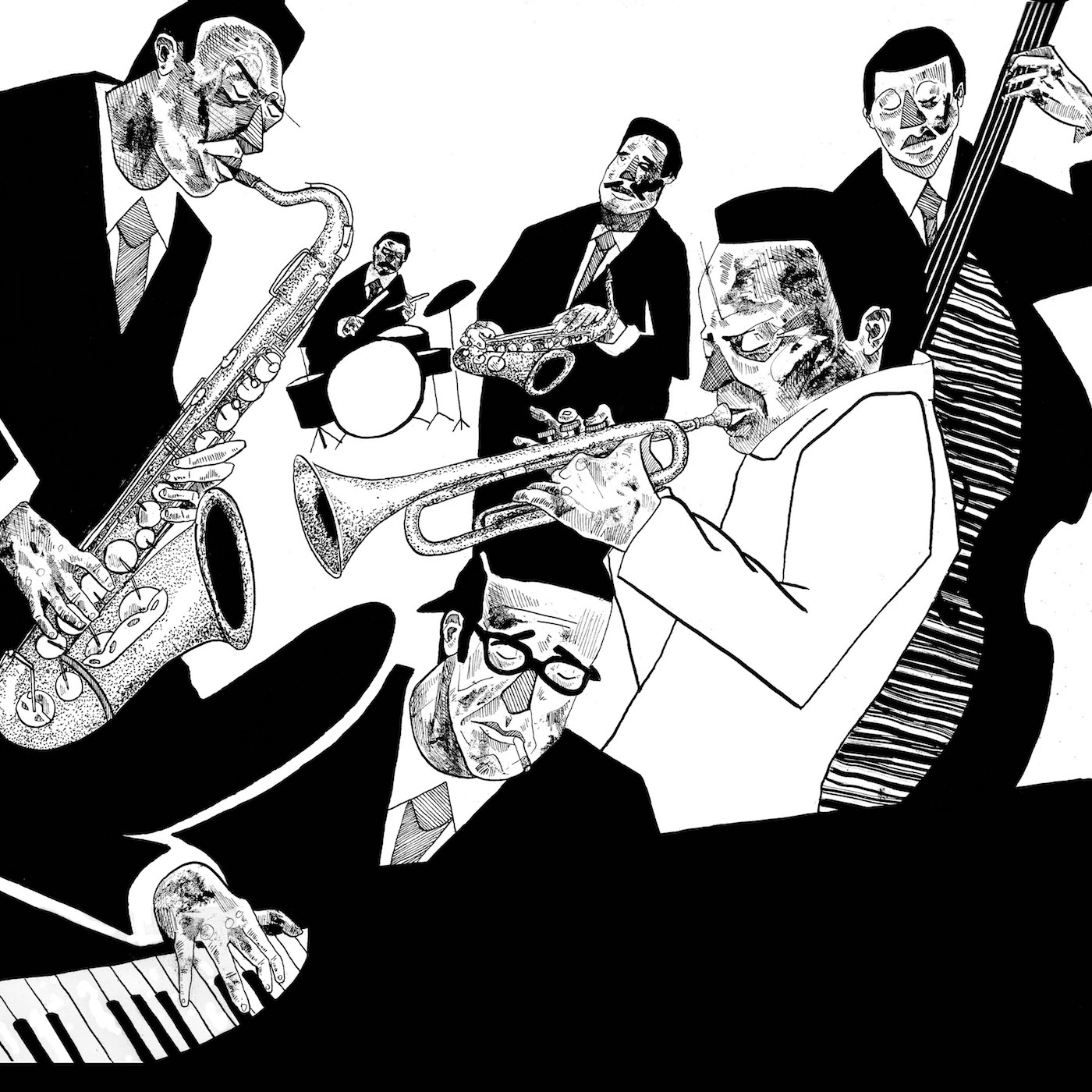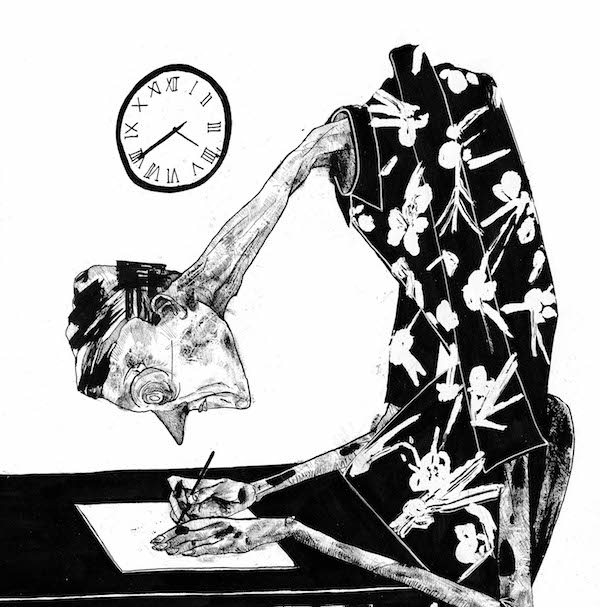Guest Album Review – “Kind of Blue” by Miles Davis
This guest review was originally part of a music blog project I created called Under The Deer. Since that site won’t be around forever, I’m archiving these wonderful reviews and their accompanying illustrations here. Writer and illustrator listed at end of the review.
The bass begins the conversation by providing a statement which is answered by two piano chords. It almost sounds like both instruments are warming up as they acknowledge each other.
The bass then anchors a pedal tone creating the backdrop as the piano chords linger in the air like cigarette smoke accented by poor lighting. The atmosphere is dark and moody while the instruments seem to be randomly offering improvised phrases.
There’s a three-bar phrase that’s played together. An intimate conversation that only these two instruments seem to understand. The piano gains momentum playing simple triads, but, the chromatic movement offers an air of tension.
The bass rumbles some off-handed comment before inviting the drummer to join them.
Eight measures later, the horns enter, and the stage is set. We’ve all been invited into the conversation.
Twenty four measures later, the cymbal crash announces Miles’s solo.
It was the early ‘80s, and I was listening to 88.3 FM (aka “Jazz 88”) on a transistor radio not-so-secretly hidden under a pillow in my darkened bedroom. I was 12 years old and worked for the local butcher in Queens, NY. I swept the floors, cleaned chicken grease and chopping blocks, knives, and countertops. The money I made was quickly invested in my music education at the local record store where I’d purchased Led Zeppelin, Pink Floyd, Van Halen and other music of the day. Kind of Blue was my first jazz album and soon became the soundtrack for my high school and college years.
Jazz music was filled with complexity. It took work to listen to and to try to play it was even more challenging. It required commitment from both artist and fan. The perfect combination of elements for a young music nerd. Many of my friends did not know of my new musical discovery. It was confined to conversations with my guitar teacher, other music geeks that hung out at the music store, and my neighbor, an older gentlemen and jazz drummer named Bobby.
There are many sub-genres of jazz and some of them I struggled with early on. I enjoyed the swing era and the big band sounds, then I heard bebop and loved the energy but had trouble understanding it—I didn’t know what to listen for and would easily get lost. I wanted to like jazz, but it wasn’t until Kind of Blue came along that the door to my lifelong love and obsession for jazz was opened.
Kind of Blue is one of the most famous and successful jazz albums ever made and was recorded in two separate sessions during the spring of 1959 and released in August of that same year.
The album’s all-star lineup featured Miles Davis on Trumpet and Session Leader, John Coltrane on tenor saxophone, Julian “Cannonball” Adderley on alto saxophone, pianist Bill Evans (with Wynton Kelly replacing him on “Freddie the Freeloader”), Paul Chambers on double bass, and Jimmy Cobb on drums. All of these fine musicians had long careers, and all would go on to lead their own bands. Except for Paul Chambers who passed away in 1969 at the age of 33.
 The album’s composers, George Russell, Gil Evans, Bill Evans and Miles Davis all knew each other and were all interested in exploring modal jazz. In modal jazz, the harmony and chord structures move in a non-traditional manner. Rather than basing their improvisations on chords and arpeggios, the players approach their solos in terms of these groupings of notes. The foundation is pared down to the bare minimum, offering the improvisers greater freedom.
The album’s composers, George Russell, Gil Evans, Bill Evans and Miles Davis all knew each other and were all interested in exploring modal jazz. In modal jazz, the harmony and chord structures move in a non-traditional manner. Rather than basing their improvisations on chords and arpeggios, the players approach their solos in terms of these groupings of notes. The foundation is pared down to the bare minimum, offering the improvisers greater freedom.
The 1959 recording sessions for the album were a conceptual experiment. That is one of the reasons why there aren’t many alternate takes. In fact, only Flamenco Sketches has two full versions. Miles had a lot of influence with Columbia Records at the time, and the company provided him with the liberty to explore this new direction.
These sessions were recorded in the late fifties and therefore we’re listening to 1950’s recording technology. The modern technique of “close miking” (placing the microphone right in front of the instrument and recording that instrument to one track) was not being used. All of the musicians played at the same time in the studio with the drums having some baffles to control the sound, but that was essentially it.
The recordings in those days were done with two machines: the master machine and the safety machine. The safety was just that, a backup in case the master went down. On these sessions, the master machine accidentally ran slow and, therefore, to play along with these recordings, musicians have had to tune down to accommodate the slower playback speed. This wasn’t discovered until the early ‘90s when the master and safety were compared. It has since been addressed in the remastered version of this recording. The first two tracks were recorded during the first session (2 March 1959), and the remaining three tracks were recorded during the second session (6 April 1959).
There were no splicing or studio recording tricks. Each track was a complete “take” or performance by the musicians the whole way through. There are alternate takes (or versions), but most of them are not complete—they are simply false starts. What we listen to are the live, one-time-performances of these songs.
During the recording session, none of the compositions had titles, they simply had track numbers or some other defining attribute like: “Fun Song,” “Mysterious Song,” or “Spanish Song.” The official song titles were added after, and a couple of the pieces only existed as basic ideas.
Often, the misconception with the album’s title, Kind of Blue, is that this is a blues recording or an exploration of the blues style. However, “blue” doesn’t mean blues in this case, but moody. All of the tempos are slow while the textures created are transparent and ethereal.
So What (2 March 1959): The opening track, So What, sets the tone. The loose interplay between Bill Evans and Paul Chambers announce that this is not your traditional jazz recording. Rather, it sets an ethereal atmosphere where everything is allowed to develop. The melody is in the bass, letting the listener know that what they’re listening to is something different. So What is the perfect example of a modal composition: The “A” Section is based on a particular group of notes, while the “B” section uses the same formula of notes a half-step higher.
Also, the three horns play impressive solos that are quite different: Miles breaks his solo down to the essentials, Cannonball uses chromaticism, almost as though he’s searching for chord changes, Coltrane demonstrates his sheets-of-sound approach as well as his comfort with the modal style. And on piano, Bill Evans mirrors Miles with a very stoic approach to improvising.
Freddie the Freeloader (2 March 1959): This track features Wynton Kelly in the piano chair and is a traditional 12-bar blues with an unexpected twist at the end of the first 12-bar section, followed by a more traditional 12-bar section. Freddie the Freeloader is relaxed and has a very simple two-note motif as the melody. Here, we can hear the different playing style and swing approach provided by Kelly’s piano accompaniment. This is arguably the most conventional track on this album.
Flamenco Sketches (6 April 1959): This is the only track that has two full takes. It’s one of the most interesting songs—in terms of modal construction—on this session as the tune is based on different tonal centers or five different groupings of notes.
The introduction song was written by Bill Evans and was featured on his 1958 recording, Peace Piece from Everybody Digs Bill Evans. In fact, the theme from Peace Piece is the basis for Flamenco Sketches. The structure of this composition makes it possible for the soloist to dictate when to transition from one tonal center to the next—unlike traditional song forms, where each section is 8, 12 or 16 bars. This makes it quite challenging for the bass player and pianist to transition from one tonal center to the next as there is no predetermined structure for the solo section. The tune organically evolves as each soloist takes center stage.
Blue in Green (6 April 1959): The shortest, most harmonically complex and unusual in terms of song structure. This tune is only ten measures long but has some quite unexpected chord changes that spiral throughout. The introduction to this piece brings to mind a collaboration between Bill Evans and Chet Baker on the song, Alone Together, which was recorded in 1958, about six months before the Kind of Blue sessions.
Miles does a masterful job of drawing out the melody with his use of subtle vibrato coupled with ornamental slides and his trademark Harmon mute. The use of the mute changes the timbre, feel and texture of the music.
This composition is not a modal piece, per se, due to the harmonic structure; however, the 10-measure form creates an ethereal landscape for the soloists. Adderley does not solo on this song, but, Miles and Trane offer powerful improvisations as well as Bill Evans (who solos twice).
All Blues (6 April 1959): The final track, is a waltz, not a blues, as it falls more easily into the category of modal music. Traditional blues transitions to the IV chord (or from G7 to C7) and, here, they move from G7 to Gm7 (or G Dorian) which is a different kind of sound. It can be counted in the traditional “1, 2, 3” waltz style or in the 6/8 time signature. Also, the dissonant chords before the turnaround add to the charm.
The song is set up by the horns playing a seductive phrase with Bill Evans applying an underlying tremolo, while Jimmy Cobb’s brushwork propels the song towards Miles’ entrance and his haunting approach to the melody. Miles plays the melody twice, then, during the 4-bar segue, he removes the Harmon mute and begins his solo which is signature Miles. That is to say; he is not playing blues, bop, cool, modal, etc.—he’s just playing Miles.
Cannonball approaches his improvisation in a traditional blues/bebop manner, and it almost feels as though he’s searching for the IV chord—and, please don’t misunderstand me, Cannonball plays a great solo, this is merely an observation. Finally, Coltrane outshines the other improvisers with his modal comfortability, technical prowess, and his use of odd-note groupings.
Kind of Blue changed the face of jazz and set the stage for moving away from traditional harmonic and song form approaches to the sounds that were further explored in the 1960s. Three of the five tunes have become jazz standards. In addition, Kind of Blue also provided improvisers with other possibilities for soloing.
The group was filled with innovative musicians who were constantly moving forward and, shortly after this recording, moved in their own directions. Later in 1959, Cannonball Adderley formed a group with his brother Nat. Coltrane left next and was probably the player that transitioned most easily into the modal style of playing as became apparent with his work in the 1960s. And, Bill Evans formed his own trio with Scott LaFaro and Paul Motian where he continued to develop this modal approach.
Miles continued to innovate styles and influence musicians. He formed his “Second Great Quintet” in the mid-60s which included Wayne Shorter, Herbie Hancock, Ron Carter and Tony Williams. This was later followed by his Bitches Brew sessions that are said to have launched the jazz fusion style. This fusion group consisted of many musicians including Chick Corea, Joe Zawinul, John McLaughlin, Dave Holland, and Jack DeJohnette.
Miles took a hiatus in the ’70s and reemerged in the ’80s, still exploring new ideas and different sounds. He passed away in Santa Monica, California due to a cerebral hemorrhage followed by a coma.
Kind of Blue strongly influenced musicians in many different genres from the funk and R&B players of the 60s to players as diverse as James Brown, Jimi Hendrix, Donald Fagen, Pee Wee Ellis, Maurice White, and The Doors. And it will continue to inspire generations of musicians to come.
Contributors

Ed Lozano is a professional guitarist, instructor, producer and published author. He is a graduate of Berklee College of Music and lives in the Andes mountains. He’s worked with Bob Dylan, Paul Simon, ACDC, Keith Urban, Randy Jackson and many others.
